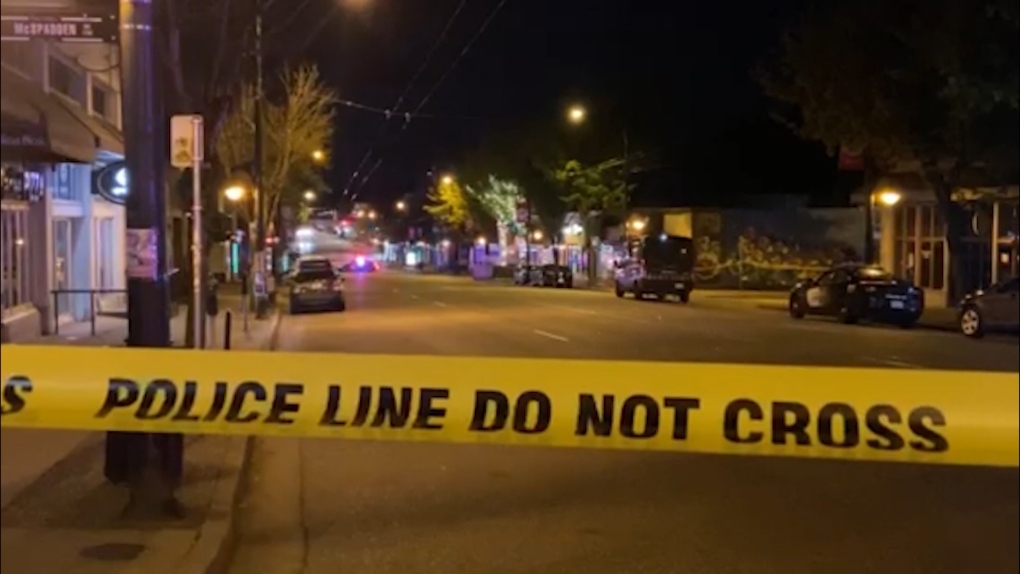B.C. saw 21% increase in homicides last year, according to Statistics Canada
 (FILE) Police tape is seen blocking part of Commercial Drive in East Vancouver.
(FILE) Police tape is seen blocking part of Commercial Drive in East Vancouver.
New data released Wednesday by Statistics Canada shows the homicide rate in B.C. rose significantly last year.
The latest statistics indicate that there were 155 homicides in the province in 2022 – 30 more than the previous year and 55 more than 2020.
The spike in homicides represents a 21-per-cent increase year over year.
Homicide rates increased overall in Canada last year, but only by eight per cent.
Manitoba had the biggest increase of all provinces, with a 40-per-cent spike last year. Homicides in that province increased from 4.45 per 100,000 population in 2021 to 6.24 in 2022.
New Brunswick had the second-biggest rate increase at 33 per cent, followed by B.C. and Quebec, both with a 21-per-cent increases.
In Metro Vancouver, there were 73 homicides last year, 13 more than the previous year. That represents an 18.3-per-cent homicide rate increase over the preceding year.
GANGS, FIREARMS TO BLAME: CRIMINOLOGY PROFESSOR
Much of the increase in homicides in B.C. can be attributed to gangs and gang-related violence, said Rob Gordon, a criminology professor at Simon Fraser University. He told CTV News he hasn’t heard of any dramatic increase in homicides stemming from other factors such as family disputes.
Gordon said in order to address the homicide rate, two main elements need to be dealt with: the gang-run drug trade and firearms, particularly handguns.
“These are guns that have gotten into the hands of these gang members; they’re using them to take out rivals,” he said.
According to Statistics Canada, gang-related homicides account for 23 per cent of all homicides Canada-wide, and firearms were used in 41 per cent of all homicides.
Zooming in on gang-related killings, 82 per cent were committed with a firearm, including 70 per cent that used a handgun, specifically.
Gordon said gun-control is difficult in the Lower Mainland due to the proximity of the U.S.-Canada border.
“It’s no secret Zero Avenue in Surrey and Langley and so forth has a great opportunity there to pass materials across the border very, very quickly and largely unseen,” he said. “We’ve got an unguarded stretch of border and what’s a problem there is we’re neighbours to one of the largest private arsenals of weapons in the world. The U.S. can get these weapons very easily and there’s a market for them here.”
He said he’d like to see a better breakdown from the solicitor general of what weapons are involved in homicides in the province.
“(There’s) always concern when you see stats like that, and I know they increased in a number of provinces as well,” Mike Farnworth said when CTV News asked about the increase outside the legislature Wednesday.
“It’s important that we continue to make investments and give support to the police, which we have been doing,” he said, adding that over $100 million in funding has gone toward anti-gang-violence programs in B.C. this year.
“It’s important to recognize that while many of the homicides are gang-related, we also know that domestic violence plays a terrible toll in terms of homicides,” Farnworth said, pointing to the development of a gender-based violence action plan announced in 2021.
Gordon pointed out that homicide accounts for less than 0.2 per cent of all police-reported violent crimes in B.C.
“(It’s) troublesome, but it’s small,” he said. “(The increase) is a disappointing development, but we should not panic about it.”
CTVNews.ca Top Stories

LIVE UPDATES Multiple homes, businesses 'lost' to wildfire in Jasper National Park: Parks Canada
Officials from Parks Canada and Jasper say "multiple structures, including a number of businesses and homes, in and around the town of Jasper, have been lost" to wildfire in Jasper National Park.
Alberta premier says a third, perhaps half, of all Jasper buildings destroyed by fire
Alberta Premier Danielle Smith says early reports indicate a third and perhaps up to half of all buildings in the historic Rocky Mountain resort town of Jasper have burned in a wildfire.
Prince William's 2023 salary revealed in new report
Newly released financial reports show that William, the Prince of Wales, drew a salary of $42.1 million last fiscal year, his first since inheriting the vast and lucrative Duchy of Cornwall.
Tourist suffers 3rd-degree burns to feet after losing flip flops amid soaring temperatures in Death Valley
A tourist was hospitalized after suffering serious burns on his feet on Saturday when he lost his flip flops at a U.S. national park where temperatures soared past 48 Celsius.
'There's mom and dad's house': New video appears to show destruction of Jasper neighbourhood
Video posted to social media on Thursday morning appears to show the charred remains of a Jasper, Alta., neighbourhood.
Former judge with disputed Cree heritage likely has Indigenous DNA: law society
The Law Society of British Columbia says a DNA test shows a former judge and Order of Canada recipient accused of falsely claiming to be Cree "most likely" has Indigenous heritage.
Australian field hockey player opts to amputate part of his finger in order to compete in Paris Olympics
In the run up to the Paris Olympics, athletes have been stepping up their preparations in order to maintain their edge over competitors. But for Australia’s Matt Dawson, those preparations looked a little different this year, with the field hockey player opting to have part of his finger amputated in order to compete in the Games.
Canada to bring home fewest Olympic medals since 2012, according to forecaster
Fewer Canadians are expected to reach the Paris podium than in the previous two Olympic Summer Games, a global data analytics company predicts.
Jennifer Aniston criticizes JD Vance for 'childless cat ladies' remarks: 'I pray that your daughter is fortunate enough to bear children'
Jennifer Aniston is criticizing JD Vance for comments he made in his past about women without children.
































